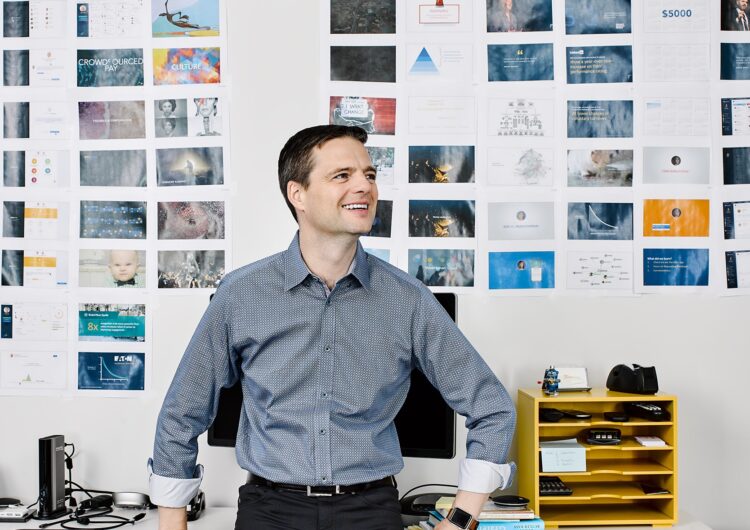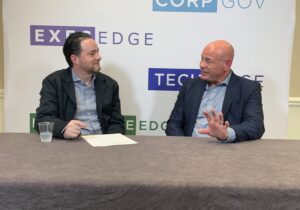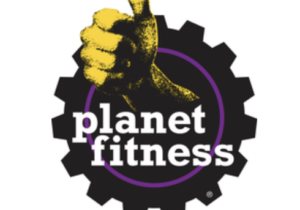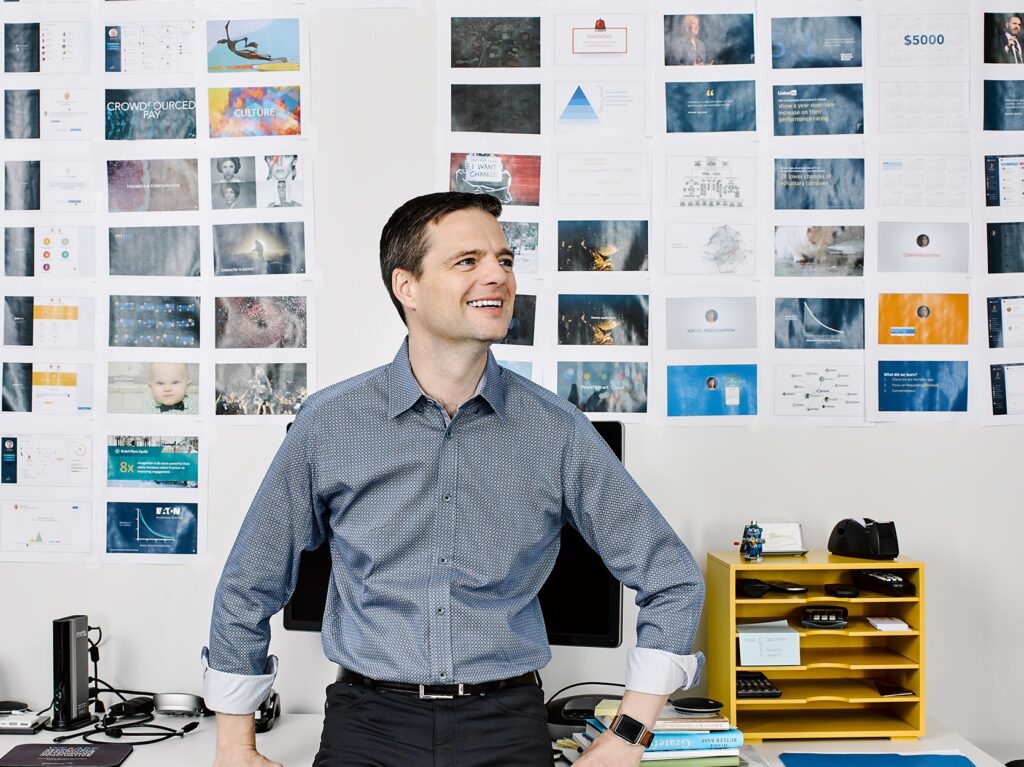
Workhuman Co-Founder and CEO Eric Mosley
From the dotcom bubble, to the financial crisis, to the current pandemic, Eric Mosley has seen his share of crises. But the co-founder and CEO of Dublin-based Workhuman, now valued at more than $1 billion, said lean times can teach valuable lessons.
Those lessons seem to have paid off for Workhuman. More than 5 million employees across 160 countries use its cloud-based workplace performance management platform that allows colleagues to recognize each other’s work. Its customers include Microsoft’s LinkedIn.
In an interview with Exec Edge, Mr. Mosley said for a company to be able to evolve and change, it must create a mission-based culture. The full interview is below:
Exec Edge: You have quite a fascinating background. Can you talk about how your upbringing has shaped your business philosophy?
When I was at a very young age growing up in Ireland, I was incredibly interested in business. My whole life, I’ve always had a few business ideas going on in my head at any one time that I was cultivating, researching, or just dreaming up. Even now.
Luckily, since we’ve built Workhuman as a platform of products, those business ideas can be within the same company, possibly materializing as improvements to existing offerings or entirely new business lines – not necessarily an entirely new business.
As for my personal business philosophy, to help channel those ideas in an energetic, entrepreneurial mind, I would say, “don’t wait, just start testing.” Take a leap of faith, a calculated risk, and just get going. Don’t get stuck in place by analysis paralysis, since no business is perfect from the start – and rarely is there a startup that develops into exactly the idea or business plan it was formed around. Ask any entrepreneur, and they’ll say they’ve learned more from the failures than the successes – and the key is turning those learnings into positive movement, making adjustments and pivots along the way. Sure, it can be dispiriting at times, but that process helps forge stronger, more resilient businesses.
Exec Edge: What are some of the lessons you learned from starting out right before the dot com crash?
Building and sustaining any size company is hard, so you might as well build one that can scale. One of the nuances of forming startups out of Ireland is that you need to be able to support global requirements from launch – dealing with language, currency, and regulations among other things. It is just part of our geography and an essential, evolving part of our business culture. So while it perhaps makes for a more challenging start, compared to a US startup that is primarily focused on its domestic audience in the early stages, our need to build a business and solution that could be deployed globally resulted in launching with distinctively large addressable market in front of us.
This, in fact, turned into our great advantage. As a pioneer and first mover in the space, we were able to get early wins with large corporations – several in the Fortune 500 – which had global operations, and thus, a need for a global solution. Not surprisingly, big companies typically require big contracts, which helped shorten the distance to profitability of our little startup.
As for the dot com crash, it brings into focus the need to build a company that is equal parts: sustainable (built for the long term), resilient (having a team and business model that can face unpredictable market challenges), and agile (showing the speed and flexibility to adjust or fully pivot to address rapid market shifts or capitalize on newly apparent revenue opportunities).
Fortunately, those are tenets that we ensured were essential underpinnings of Workhuman, which served us well over 20 years, and especially in the current market environment and worldwide pandemic we find ourselves in now.
Exec Edge: Now that your company has achieved “unicorn” status, how do you plan to continue growth and build value?
Over the past eight years especially, our growth has been accelerating. We’re proud to have built a billion dollar business based on recognition, but even more importantly, we’re thankful for the response and ongoing support of our customers who see the value in fostering social recognition and social pay in the workforce, which is the biggest reason for our 20-30% year-over-year growth.
More than the dollar figure, our growth into a unicorn is recognition that the underlying concept of the Workhuman mission has actually become part of the zeitgeist in the business world – influencing how corporate cultures are both created and sustained for the mutual benefit of both company and employee. This shared purpose is largely the reason why we can achieve a 98% retention rate.
While we’ve been at this for 20 years, we still feel like we are on the ground floor – especially as we begin to expand more meaningfully across Europe and other regions worldwide. In addition to entering new geographies, we are also adding to our suite of human applications to deliver more capabilities and measurable value to our customers, which in turn, contributes to our own net expansion on the enterprise level.
We also felt like we started with the hard part of developing solutions for large, global corporations, and now have the opportunity to create solution sets that have capabilities and pricing more tailored for the needs of mid-market and SMBs – which can significantly grow our TAM.
The reality is that any company that has employees could be a fit for Workhuman, so we’re excited about our ability to help any company of any size or business stage galvanize their workforce.
We believe demonstrating appreciation through recognition will never go out of style, which makes for a very sustainable business capable of consistently steady growth over the long run.
Exec Edge: How long until “social pay,” as part of peer-to-peer recognition programs, becomes a standard portion of payroll for large corporations? Do you see social pay also becoming widely adopted by mid-sized companies and SMBs?
Companies that are succeeding today are those that show they are committed to treating employees like human beings, not strictly as human capital. These are also the companies that care about being progressive and inclusive – with more and more gravitating toward the concept of “social pay,” also called “agile pay” or “crowdsourced pay”, where they are allocating a range of 1-2% of their payroll to fund it.
Today, companies and their workforces are being asked to do more with less. And in light of the economic pressures brought on by the effects of the pandemic, many companies may not be able to sustain their traditional size and tempo of bonuses and raises – meanwhile, employees are still working extra hard.
So social pay has multiple effects – offering alternative compensation opportunities throughout the year as well as rewarding great work as it happens and often when it is most needed. Putting the decision of these social pay rewards into the hands of peers in the workplace, rather than just senior managers, also facilitates a more fair, authentic distribution of funds and acknowledgement of who is doing the best work from those who are also in the trenches doing the same work alongside that co-worker.
This form of crowdsourced pay moves a portion of compensation into a social construct. Of course, there are checks and balances along the way, but decisions about the distribution of that allocation of funds becomes much more democratized and truly merit based. Even at 1 cent on the dollar, the effect of the cost is grossly disproportionate to the receiver, who perceives that reward at a much higher value.
We have already seen this concept well received by large corporations, which will likely be the earliest adopters setting off a network effect. And I would predict that SMEs will be close behind.
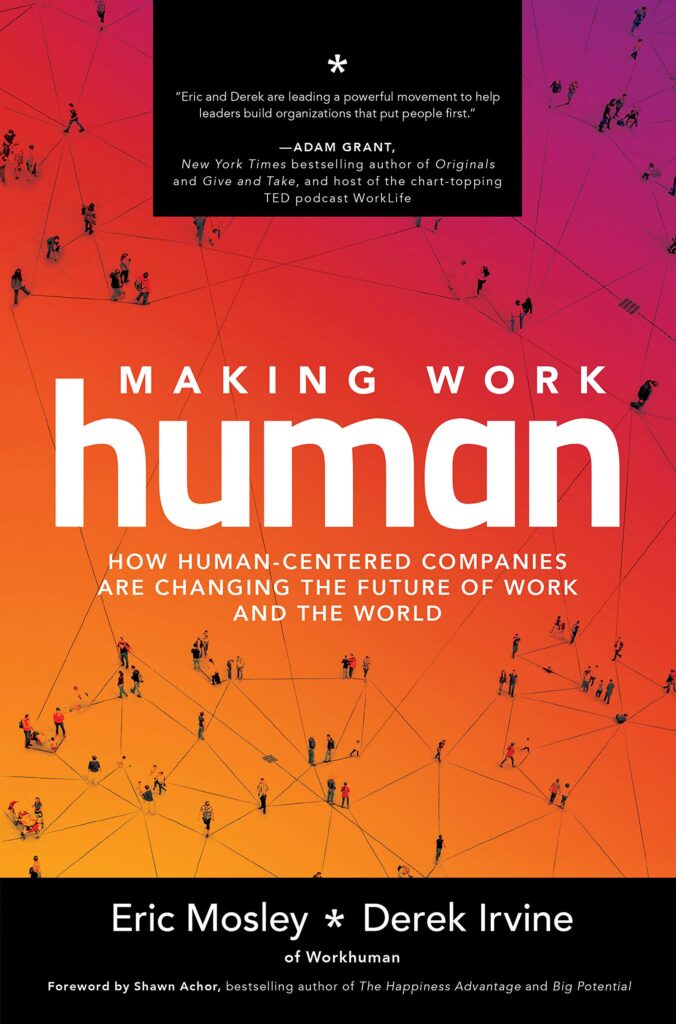
In fact, research shows that Workhuman customers that invested more in recognition programs had higher productivity, with investments of 10% more per employee showing an average higher productivity of $3,900 per employee. For a typical 15K person organization, this is an annual benefit of $58 million compared to industry peers.
I am a strong believer that iconic brands shift stakeholder expectations, and that is what Workhuman intends to do.
Exec Edge: You wrote in 2015 that positive reinforcement of employee behavior can boost retention and business outcomes. How have performance reviews and recognition evolved since then, and how can social recognition add to your customers’ bottom lines?
Interestingly, this thesis has not only become our ongoing mission but has also developed into a book I co-authored with Derek Irvine, Workhuman’s SVP of Client Strategy & Consulting, entitled: Making Work Human: How Human-Centered Companies are Changing the Future of Work and the World.
Today, retention is only part of the picture. On a grander scale, companies are using recognition to truly galvanize their workforces to maintain alignment on key goals, drive innovation breakthroughs, achieve greater efficiency, and improve performance gains – all with direct impact on bottom line results. These moments that matter in life and work, which are critical to recognize and celebrate, turn into performance that matters for the health and success of the business.
We feel there is a clear reason why we signed contracts worth $50 million and an additional 300,000 of our customers’ employees were added to the Workhuman Cloud platform in just the first half of this year. Employee recognition is no longer a nice to have, it is a must have. While we used to primarily sell into the HR department, we now have more frequent conversations with the C-Suite, as employee engagement has thrust itself atop the CEO agenda.
And beyond reviews, we are seeing the intense desire to keep a more accurate pulse of employee sentiment – from job role satisfaction to pay equity to diversity and inclusion. This isn’t just a curiosity, it is a growing megatrend, especially among large enterprises. More and more, executives are realizing that the unrest we see in society can quickly permeate the workplace. Their lesson: people want to work for companies who care about the world the way they do.
Workhuman allows companies to identify and measure how different segments of their employee base are being treated and recognized by peers and managers, alike. When they analyze the data, they are able to discern the often subtle but meaningful trends around gender and race distributions relative to value and recognition in the workplace. Up to this point, the ability to do this has been largely out of reach. It is nearly impossible to implement effective, lasting change to achieve diversity and inclusion improvement if you cannot quantify the issues in the first place. What is abundantly clear, and now largely accepted, is that training once or twice a year is not making enough of a difference. With Workhuman, they can identify these overt or unconscious biases “in the moment” and quickly activate micro-training, to either introduce or reinforce key principals in real context, throughout the week, the month, the year.
In many ways, we feel Workhuman can become the tip of the spear when it comes to diversity, equity, inclusion, and belonging in the workplace. And the response of Chief Diversity Officers has been tremendous. Together with our clients, we’re grateful that our solution has the ability to effect change and show true progress on this front.
Exec Edge: You seem to have few, if any, direct competitors of your size in this market segment – why is that?
We feel we have carved out a very unique position in the market. If you were to visualize Workhuman’s business model as a Venn Diagram, you would see concentric circles for Employee Recognition, Performance Management and Development, Collaboration, and eCommerce. So, this combination in a single platform that can be deployed at scale is quite unique. And all of these are tied directly to measurable bottom line business outcomes.
If you look at the recent mass adoption of applications like Slack and Zoom, there is a clear trend toward improving connectivity, productivity, and communication. COVID didn’t create this movement, but it certainly accelerated it. You can argue those apps may improve how we work, but they don’t fundamentally change the work itself. We feel Workhuman actually brings about a seismic shift in the way we work, flipping the traditional top-down manager-driven performance model into a process that is predominately peer-influenced. It provides both insights and actions to lift culture, energize employees, and boost bottom line results.
On the flip side, ERP and HRM systems are important plumbing. They digitized and automated the mundane, but nobody can claim that these platforms either energize or galvanize a workforce. And that is exactly where Workhuman comes in, to change how employees are motivated and work, all in a more distributed way.
A great example of how Workhuman truly stands out is how it was used during the COVID outbreak. When morale was plummeting and both fear and concern reigned among the workforces at many Fortune 500 companies, they did not turn to their HR systems of record for help – instead, they turned to Workhuman as a way to engage, encourage, and empathize with their employees. Our platform served as the connective tissue between employee needs and business needs. There was a significant burst of activity by companies who were able to crowdsource gratification among their employees, tie moments of recognition to key company objectives and corporate culture (ranging from innovation to resiliency), and ultimately galvanize workforces as their companies faced down unmatched historical hurdles and headwinds.
Exec Edge: What is the next major milestone for the company? Do you see an entry into Capital Markets in Workhuman’s future?
I feel we have a very attractive profile for the Capital Markets, given our cloud-based platform model combined with the way our top line revenue and profitability has taken off like a rocket ship! In fact, we feel the makeup of our business advances the traditional SaaS model, as we layer in many other transaction and revenue channels as a natural extension of our software subscriptions and marketplace. For every recognition and reward moment, there is potential for Workhuman to make money – so our business model is a cash flow machine, which investors surely value.
It took us 12 plus years to achieve $100 million in revenue per year, and now we are steadily adding $100 million yearly to that figure, surpassing $550 million in revenue in 2019. The fact is, we’ve always been a growth story, and we’re confident that will continue. We hired another 100 people in the first half of this year, in spite of the impact of COVID, and will continue to expand our own workforce.
Our operations have been very much self-sustaining and profitable, with only a limited amount of capital raised from outsized sources – nearly all of whom received roughly 100x on their early investments when we changed our capital structure recently and allowed our angels to exit and realize their gains. So, we have already delivered shareholder value, and feel we are setup now to do that at scale.
ICG’s investment ostensibly cleaned up our cap table and made the company more “efficient” should it choose to go public. Fortunately, we don’t need funding, so an IPO would essentially be utilized to fuel hyper-growth and keep up with skyrocketing demand.
We can realistically provide service to every company on earth, which is quite unique. Any company that has employees is in our TAM.
Exec Edge: What business lessons have you learned from the current pandemic? And have customers started to use Workhuman Cloud differently during and following the outbreak?
If you were a company with 100 or 100,000 people, you largely faced the same problem – how do we galvanize our workforce? We knew that recognition helps build deeper relationships and make businesses more agile, and our customers experienced that first-hand over an emotionally charged, and highly condensed time period.
The biggest lesson we learned during this monumental period in our history is that social recognition and continuous performance management solutions are an essential spend for companies, no matter the industry segment.
We saw these huge corporations among our client base needing to turn their businesses on a dime, to react to the situation. Company cultures went immediately into critical care, with the widespread confusion, concern, and fear. We knew we could help them respond appropriately and effectively via the Workhuman Cloud, for the sake of all parties involved.
The majority of these companies wanted to thank and reward their employees, who were asked to put in extra effort, as many of their goods and services were in high demand during the pandemic. As a result, we saw the use of the Workhuman Cloud platform explode across the board — with recognition messages, rewards, and redemptions skyrocketing.
Our business grew 40% year-over-year in April 2020 alone, showing a huge amount of interest in our platform as much as the concept of showing appreciation, en masse, across organizations. This turned out to be a critical aspect of helping businesses persevere through a historically challenging time – maintaining morale, sustaining performance, and keeping their companies afloat.
Then, as our personal and business lives progressed, Workhuman was used to provide a way to bring company culture out of the office and into the home, to support a predominately remote workforce. Workhuman Cloud was able to do what other platforms could not. More than facilitating communications, it facilitated connections – and helped businesses stay on track.
Exec Edge: How would you describe your management style? Has it changed since the start of the year?
You could probably guess my management style by our own company brand – Workhuman. To me, it is all about bringing more humanity to the workplace. There is clearly lots of value in automation these days, but I am a strong believer that employees are a company’s most valued assets – so you have to show that you, as a boss or manager or co-worker, value the fellow humans you work with. It seems so practical, but it simply doesn’t happen enough.
It also doesn’t escape me that we’ve built a billion-dollar business based on purpose-driven authentic thankfulness and appreciation. So, it is essential for me to walk that walk, and find the time to recognize and show appreciation for the people doing the work, and their efforts, not just the outcome itself. So often we praise the outcome, the win, and fall short of praising the efforts and contributors along the way.
Fortunately, there is technology available that helps us to do that, and we feel Workhuman is central to that cause. When you show recognition as a leader, and then empower others at all levels of the organization to not just share but actually reward recognition, the gains are tremendous in performance and in top talent retention and population size– equating to multiple times the value of what it costs for those rewards, or for the effort to make a point of celebrating the hard work and achievements of co-workers.
Exec Edge: Like most founders, you’ve had to make many adjustments to your business along the way. What advice do you have for entrepreneurs who are just starting out, especially in the current market environment?
Clearly, there are plenty of imitator companies out there. While you may be able to grab some market share in someone else’s sandbox, you’ll never likely be able to maintain long-term growth and sustainability as a company.
Ultimately, you need to create your own market. By default, you will be the leader – and once others see there is revenue potential in that space, you need to fight like hell to grow and protect your market share by constantly innovating and delivering value to your customers and stakeholders. Keep in mind that the market you create is going to constantly evolve and change, so as a company, you need to be agile enough to evolve and change with it. In business today, there is no true endpoint – make that work to your advantage and keep the big companies at bay.
To accomplish this, you must create a mission-based culture, with buy-in across your organization. Harness all the imagination and energy of all your staff and point them in the right direction. It is harder than it sounds and often becomes the lifelong pursuit of any leader, but done right, this is how you can ensure your long-term success.
Jarrett Banks
Editor-at-Large
jb@capmarketsmedia.com
Twitter: @Exec_Edge

